Everest Memory Performance-
We are providing results with Everest 4.0 as this program is widely available and generates reliable results that can be replicated easily. Our results are based on the best possible memory timings and strap choices we could manage at each setting listed. Please remember, this is not a memory review or in-depth analysis of the memory and motherboard (those are coming along with application results). We are providing a few initial results with this new beta BIOS to show a glimpse of its current capabilities.
10x266FSB 2672MHz 5-5-5-15 1T 800 Strap DDR3-1066
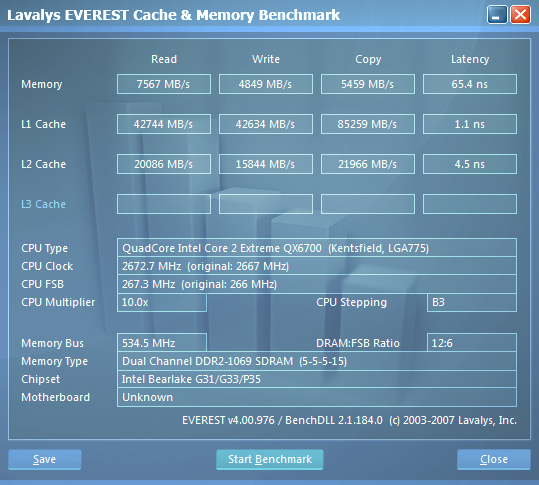
8x333FSB 2671MHz 6-6-6-18 1T 800 Strap DDR3-1333

10x360FSB 3600MHz 7-7-7-18 1T 800 Strap DDR3-1440
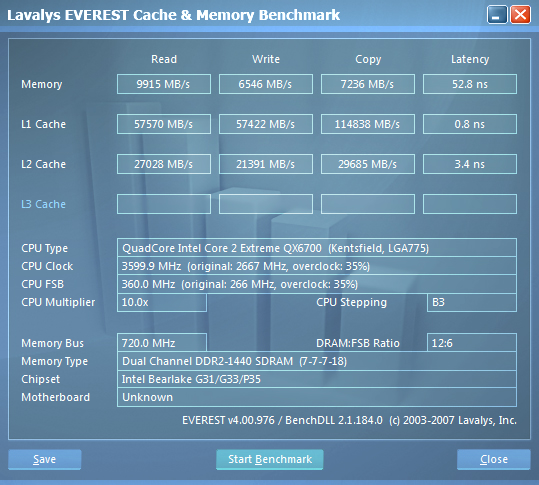
9x400FSB 3600MHz 7-7-7-24 1T 1066 Strap DDR3-1600
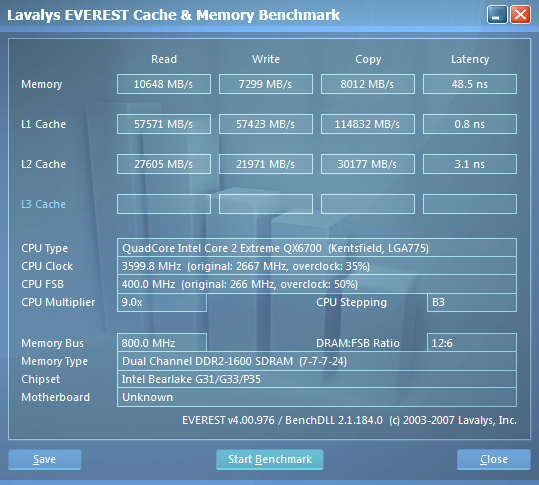
8x450FSB 3600MHz 8-8-8-24 2T 1066 Strap DDR3-1800
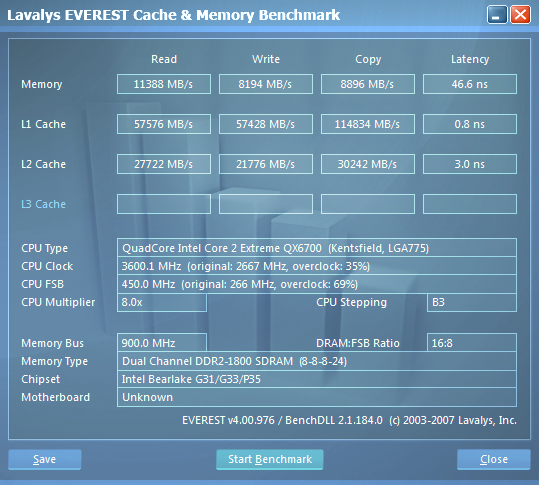
8x465FSB 3720MHz 8-8-8-24 1T 1066 Strap DDR3-1860

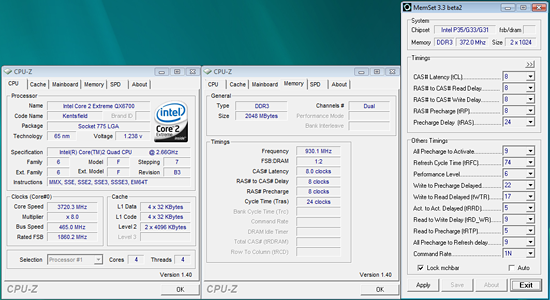
Our first two tests are with the processor set to its stock speed setting of 2660 although the final speed is at 2671+MHz due to a slight difference with the true FSB speeds. Read speeds improve by 15%, write speeds by 25%, and latency by 10% between our 1066 and 1333 memory speeds. We were able to run the system at the 800 memory strap easily up to the 333FSB setting which was impressive to us at first.
However, the actual difference between this and the 1066 strap was less than 2% in our initial comparison tests. The reason being that internal chipset latencies are really loosened up starting about 310FSB in order for the memory to run on the 800 strap. This is an area where ASUS is still fine tuning the BIOS for both performance enhancements and stability. We are also hoping they will allow us to eventually manipulate the chipset strap and latencies. Once the BIOS is finalized we will provide actual comparisons between each strap change but for now the differences between the 800, 1066, and 1333 straps average around 2% between each setting.
Our limit on the 800 strap was around the 360FSB mark with this particular processor. Our E6600 was unable to do more than 320FSB stable yet our E6420 was able to reach 380FSB on the 800 strap. Once we switched over to the 1066 strap for the 3600MHz settings things got interesting between the 400FSB and 450FSB results. We have a 12% increase in the FSB setting that results in read speeds increasing by 7%, latency improves by 4%, and write speeds improve linearly by 12%. We were running 1T settings at DDR3-1600 but had to fall back to 2T at DDR3-1800 as two of our game benchmarks would not run at 1T.
Our previous best overclock results with this board and processor combination was 7x485 and 8x453 at the 1333 strap, but the memory was regulated to DDR3-1500 or under at relaxed timings of 9-7-7-20. ASUS had promised us additional overclocking potential and 1T performance on the Micron memory up to 1900MHz in dual channel mode. We hit a final 8x465FSB setting on the 1066 strap at 1.4825V which is our limit on air cooling for this processor. This resulted in a memory setting at DDR3-1860 at 8-8-8-24 1T settings at 1.95V. Unlike our 450FSB settings, 1T stability was simply superb at this setting. Although we only had a 3% increase in CPU and FSB speeds, we see read speeds improving by 7%, write speeds linearly at 3%, and latency drops by an impressive 12%.
We are providing results with Everest 4.0 as this program is widely available and generates reliable results that can be replicated easily. Our results are based on the best possible memory timings and strap choices we could manage at each setting listed. Please remember, this is not a memory review or in-depth analysis of the memory and motherboard (those are coming along with application results). We are providing a few initial results with this new beta BIOS to show a glimpse of its current capabilities.
10x266FSB 2672MHz 5-5-5-15 1T 800 Strap DDR3-1066

8x333FSB 2671MHz 6-6-6-18 1T 800 Strap DDR3-1333

10x360FSB 3600MHz 7-7-7-18 1T 800 Strap DDR3-1440

9x400FSB 3600MHz 7-7-7-24 1T 1066 Strap DDR3-1600

8x450FSB 3600MHz 8-8-8-24 2T 1066 Strap DDR3-1800

8x465FSB 3720MHz 8-8-8-24 1T 1066 Strap DDR3-1860


Our first two tests are with the processor set to its stock speed setting of 2660 although the final speed is at 2671+MHz due to a slight difference with the true FSB speeds. Read speeds improve by 15%, write speeds by 25%, and latency by 10% between our 1066 and 1333 memory speeds. We were able to run the system at the 800 memory strap easily up to the 333FSB setting which was impressive to us at first.
However, the actual difference between this and the 1066 strap was less than 2% in our initial comparison tests. The reason being that internal chipset latencies are really loosened up starting about 310FSB in order for the memory to run on the 800 strap. This is an area where ASUS is still fine tuning the BIOS for both performance enhancements and stability. We are also hoping they will allow us to eventually manipulate the chipset strap and latencies. Once the BIOS is finalized we will provide actual comparisons between each strap change but for now the differences between the 800, 1066, and 1333 straps average around 2% between each setting.
Our limit on the 800 strap was around the 360FSB mark with this particular processor. Our E6600 was unable to do more than 320FSB stable yet our E6420 was able to reach 380FSB on the 800 strap. Once we switched over to the 1066 strap for the 3600MHz settings things got interesting between the 400FSB and 450FSB results. We have a 12% increase in the FSB setting that results in read speeds increasing by 7%, latency improves by 4%, and write speeds improve linearly by 12%. We were running 1T settings at DDR3-1600 but had to fall back to 2T at DDR3-1800 as two of our game benchmarks would not run at 1T.
Our previous best overclock results with this board and processor combination was 7x485 and 8x453 at the 1333 strap, but the memory was regulated to DDR3-1500 or under at relaxed timings of 9-7-7-20. ASUS had promised us additional overclocking potential and 1T performance on the Micron memory up to 1900MHz in dual channel mode. We hit a final 8x465FSB setting on the 1066 strap at 1.4825V which is our limit on air cooling for this processor. This resulted in a memory setting at DDR3-1860 at 8-8-8-24 1T settings at 1.95V. Unlike our 450FSB settings, 1T stability was simply superb at this setting. Although we only had a 3% increase in CPU and FSB speeds, we see read speeds improving by 7%, write speeds linearly at 3%, and latency drops by an impressive 12%.










6 Comments
View All Comments
anandtech02148 - Tuesday, June 19, 2007 - link
what am to going to do with my 7gigs of ddr2 800mhz.It was a nice fire sale this season,.. the promises of vista,direct 10 games, anyone want to trade 7gigs of ddr2 for 2gigs of ddr3 when all the promises matured?
ViRGE - Monday, June 18, 2007 - link
DDR3 is going to have a really hard time taking off if the memory consortium doesn't manage to push out some good 2GB sticks soon. At this point 4GB is about to become the norm for a high-end system and 4 1GB sticks leaves no room for future expansion plus invites any problems/slowdowns that happens with 4 sticks over 2 sticks. The sweet spot needs to be 2GB sticks so that high-end computers build with DDR3 can use a 2x2GB configuration and leave the other 2 slots open for another 2x2GB set when said system gets upgraded in a couple of years.BigLan - Monday, June 18, 2007 - link
I don't really think that 2gb sticks is going to help ddr3 much, but I agree that it's going to have a hard time taking off. I actually think it'll take much longer for ddr3 to catch on than ddr2 did, which was helped enormously by Intel's chipsets only supporting ddr2 which forced dell and the big oems to transition early and helped the overall adoption rate (though AMD still stuck with DDR1 for a long time.)This time around, oems don't really have a reason to transition so will likely stay with the cheaper product for longer.
Having said that, Intel has a much bigger incentive to push ddr3 this time than they did with ddr2. AMD showed that they could not move their chips to ddr2 easily because they have to rework the memory controller and the same is likely to be true this time around. I think an early push by intel to dd3 would help them keep the performance crown for a long time.
TA152H - Monday, June 18, 2007 - link
Are you sure AMD couldn't move to DDR2? Seeing as how DDR performed as well, was there really any point to it? Originally AMD said they would go straight to DDR3 and skip DDR2, so I think it was more of a choice. Also, the memory controller on the K8 isn't designed well for DDR2, whereas the Barcelona has deeper request and response ques, so should take better advantage of DDR2. It looks like AMD changed their minds in the middle, which was probably a mistake and a waste of design resources since DDR2 pretty much sucks, at least for the K8.DDR3 should take off because it's clearly better than DDR2, and it's essentially no more difficult to make. The price will drop quickly and for whatever reason people have everything backwards. Supply/demand says that if demand is too high, price goes up, not down. So what the heck is everyone talking about? That demand will be moderate and growing should help, since every memory company knows they need to make DDR3 since it will take over, but demand isn't crazy immediately so they have time to get it right and ramp production.
wolfman3k5 - Monday, June 18, 2007 - link
When will you guys review the Abit IP35 motherboard? It's supposed to be pretty cool.TA152H - Monday, June 18, 2007 - link
Any idea why Everest is showing faster L2 cache speeds with higher FSB speeds? Seems to me Everest is rubbish and shouldn't be used if you can't trust the results, but maybe I'm missing something (although I can't imagine how, the L2 cache shouldn't care about the FSB). Is it just bad software or is there something I haven't thought of?